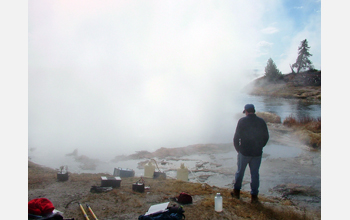Multimedia Gallery
Tom Schoenfeld monitors equipment while collecting viruses
Tom Schoenfeld of Lucigen Corporation monitors equipment while collecting viruses in Yellowstone National Park.
More about this image
Despite their relatively high abundance, viruses have a hundred-fold less DNA than bacteria. To compensate, genetic analysis requires concentrating viruses from hundreds of liters of hot springs water to obtain enough viral genetic material for study. However, this concentration step means only a small volume of water is actually removed. Despite the large volumes sampled, these viral concentrates yields only billionths of a gram of DNA. Since viruses have such small genomes, one microbial cell can be a large contaminant.
Methods to separate the viruses from the cells and make millions of copies of the viral DNA were developed to access this diversity. In collaboration with the Department of Energy's Joint Genome Institute, 30 million letters of genetic code were determined. Extensive computer analysis allowed Schoenfeld to sift through this data to find the genes likely to encode useful enzymes. Once identified, genes for useful enzymes were transferred to lab bacteria to turn them into mini factories for producing heat-stable enzymes that are studied to understand how best to use them. Often molecular engineering of the molecules is necessary to make them useful. The first of these enzymes is being sold as a tool for DNA detection and analysis.
This research was initiated through NSF Small Business Innovation Research (SBIR) Phase I and II awards (DMI 0109756 and DMI 0215988) to Lucigen. Ongoing work on the project is currently supported by an additional grant (IIP 0839404), awarded to Lucigen. (Date of Image: 2005-2007)
Credit: David Mead, Lucigen Corporation
Images and other media in the National Science Foundation Multimedia Gallery are available for use in print and electronic material by NSF employees, members of the media, university staff, teachers and the general public. All media in the gallery are intended for personal, educational and nonprofit/non-commercial use only.
Images credited to the National Science Foundation, a federal agency, are in the public domain. The images were created by employees of the United States Government as part of their official duties or prepared by contractors as "works for hire" for NSF. You may freely use NSF-credited images and, at your discretion, credit NSF with a "Courtesy: National Science Foundation" notation.
Additional information about general usage can be found in Conditions.
Also Available:
Download the high-resolution JPG version of the image. (1 MB)
Use your mouse to right-click (Mac users may need to Ctrl-click) the link above and choose the option that will save the file or target to your computer.

 All images in this series
All images in this series